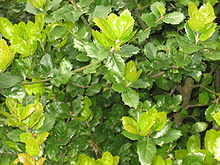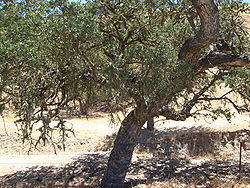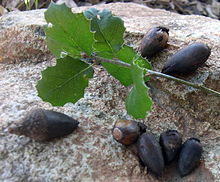- Quercus agrifolia
-
Coast Live Oak 
Coast Live Oak foliage with new spring growth Scientific classification Kingdom: Plantae (unranked): Angiosperms (unranked): Eudicots (unranked): Rosids Order: Fagales Family: Fagaceae Genus: Quercus Section: Lobatae Species: Q. agrifolia Binomial name Quercus agrifolia
NéeQuercus agrifolia, the Coast Live Oak, is an evergreen oak (highly variable and often shrubby), native to the California Floristic Province. It grows west of the Sierra Nevada from Mendocino County, California, south to northern Baja California in Mexico. It is classified in the red oak section (Quercus sect. Lobatae).
This species is commonly sympatric with Canyon Live Oak, and the two may be hard to distinguish because their spinose leaves are superficially similar.
Contents
Description
Coast Live Oak typically has a much-branched trunk and reaches a mature height of 10–25 meters. Some specimens may attain an age exceeding 250 years, with trunk diameters up to three or four meters, such as the magnificent specimens on the Filoli estate in San Mateo County.
The trunk, particularly for older individuals, may be highly contorted, massive and gnarled. The crown is broadly rounded and dense, especially when aged 20 to 70 years; in later life the trunk and branches are more well defined and the leaf density lower.
Leaves
The leaves are dark green, oval, often convex in shape, 2–7 cm long and 1–4 cm broad; the leaf margin is spiny-toothed (spinose), with sharp thistly fibers that extend from the lateral leaf veins. The outer layers of leaves are designed for maximum solar absorption, containing two to three layers of photosynthetic cells.
These outer leaves are deemed to be small in size to more efficiently re-radiate the heat gained from solar capture. Shaded leaves are generally broader and thinner, having only a single layer of photosynthetic cells. The convex leaf shape may be useful for interior leaves which depend on capturing reflected light scattered in random directions from the outer canopy.
Inflorescence and acorns
The flowers are produced in early-to-mid spring; the male flowers are pendulous catkins 5–10 cm long, the female flowers inconspicuous, less than 0.5 cm long, with 1-3 clustered together. The fruit is a slender reddish brown acorn 2-3.5 cm long and 1-1.5 cm broad, with the basal quarter enclosed in a cupule; unusually for a red oak, the acorns mature about 7–8 months after pollination (most red oak acorns take 18 months to mature).
Recognized varieties
There are two varieties of Quercus agrifolia:
- Quercus agrifolia var. agrifolia. Throughout the range of the species. Leaves that are glabrous to slightly hairy on the abaxial side, especially near the leaf vein axils. Hybrids with Q. kelloggii, Quercus parvula var. shevei, and Q. wislizenii are known.
- Quercus agrifolia var. oxyadenia. Southwesternmost California (San Diego area), Baja California. Leaves that are tomentose abaxially, with densely interwoven hairs. It prefers granitic soils; hybrids with Q. kelloggii known.
Hybridity
Several hybrids between Coast Live Oak and other red oak species have been documented. Hybrids with Interior Live Oak (Q. wislizenii) are known in many areas in northern California. Coast live oak also hybridizes with Nuttall's Scrub Oak (Q. dumosa) and Shreve Oak (Q. parvula var. shrevii). All these oak species show evidence of introgression with one another.
Etymology
The name Quercus agrifolia literally means "sharp-leaved oak", not "field-leaved oak" as is sometimes thought, nor is it an error by the describing botanist for "aquifolia", "holly-leaved".[citation needed] This species is sometimes known by the name "California Live Oak".
Habitat and ecology
 Coast Live Oak off California 101, central coast.
Coast Live Oak off California 101, central coast.
Coast Live Oak is the only California native oak that actually thrives in the coastal environment, although it is rare on the immediate shore; it enjoys the mild winter and summer climate afforded by ocean proximity, and it is somewhat tolerant of aerosol-borne sea salt. The coastal fog supplies relief from the rainless California summer heat.
It is the dominant overstory plant of the Coast Live Oak woodland habitat, often joined by California Bay Laurel and California Buckeye north of Big Sur. Associated understory plants include Toyon, various manzanitas and Western Poison-oak.
Normally the tree is found on well drained soils of coastal hills and plains, often near year round or perennial streams. It may be found in several natural communities including Coast Live Oak woodland, Engelmann Oak woodland, Valley Oak woodland and both northern and southern mixed evergreen forests. While normally found within 100 kilometers of the Pacific Ocean at elevations less than 700 meters, in southern California it occasionally occurs at up to 1,500 meters in altitude.
The California Oak Moth (Phryganidia californica) caterpillar subsists entirely on living and fallen leaves of the Coast Live Oak. In 8-10 year cycles, the caterpillar will appear in sufficient abundance to denude healthy trees. The trees recover, and botanists speculate that the species provide mutual benefit, possibly in the form of fertilizer for the oak [1]. The Coast Live Oak is also the only known foodplant of Chionodes vanduzeei caterpillars.
Economic usage
Historical usage
 Coast Live Oak at Rancho Los Encinos in the San Fernando Valley.
Coast Live Oak at Rancho Los Encinos in the San Fernando Valley.
At least twelve distinct cultures of Native Americans are known to have consumed the acorns as a dietary staple. In the 18th century Spaniards in the San Fernando Valley used the wood for charcoal to fire kilns in making adobe. Later this form of charcoal would be utilized in the baking, gunpowder and electric power industries.
In the 18th and 19th centuries shipbuilders sought out the odd angular branches to make special joints. Pioneers moving west would harvest small amounts for making farm implements and wagon wheels, but the greatest impact was the wholesale clearing of oak woodlands to erect sprawling cities such as San Diego and San Francisco. The irregular shape often let the tree escape widespread harvest for building timbers, and also led the early settlers to endow the Coast Live Oak with mystical qualities. Its stateliness has made it a subject of historical landscape painters throughout California modern history since the mid-19th century.
Modern usage
Coast Live Oak has also become a common addition to landscaping. It is however sensitive to changes in grading and drainage; in particular, it is important to respect the root crown level and avoid adding soil near the trunk when construction or landscaping occurs.
Also, if incorporating it into a landscaping scheme with artificial irrigation, it is important not to water within the oak's drip line (canopy), as wet soil in the summer increases infection rates by soil-borne Phytophthora diseases like sudden oak death.[1]
Geographical monikers
The Coast Live Oak, especially in its Spanish forms encino or encina, encinitas "little oaks", and encinal "oak grove", gave its name to seven land grants across California and to many communitities and geographic features.
These include Rancho Los Encinos, the community of Encino near Los Angeles, Encinitas near San Diego, and Encinal del Temescal, now the city of Oakland.[2]
Paso Robles ('Pass of the Oaks') also refers to oaks as a geographical place name.
Notes
- ^ J. M. Davidson (7 July 2003). "Sudden Oak Death and Associated Diseases Caused by Phytophthora ramorum". Plant Management Network. http://www.plantmanagementnetwork.org/php/shared/sod/. Retrieved 12 January 2010.
- ^ Gudde, Erwin, and William Bright, California Place Names, University of California Press, 4th edition, 1998, ISBN 0520213165, p. 123-124
References
- Flora of North America: Quercus agrifolia
- Jepson Flora Project: Quercus agrifolia, var. agrifolia, var. oxyadenia
- Balls, E. K. (1972). Early Uses of California Plants. University of California Press, Berkeley.
- Pavlik, B. M., Muick, P., Johnson, S., & Popper, M. (1991). Oaks of California. Cachuma Press ISBN 0-9628505-1-9.
- Sawyer, John O., & Keeler-Wolf, Todd. (1995) A manual of California Vegetation. California Native Plant Society, page 241.
- Native Plant Information Network More information on Quercus agrifolia
- Las Pilitas: California Oaks
- Virginia Tech Forestry Department: Coast Live Oak
- USDA Plants Database: Quercus agrifolia Née
- Interactive Distribution Map for Quercus agrifolia
Categories:- Quercus
- Flora of California chaparral and woodlands
- Trees of the United States
- Trees of California
- Trees of Baja California
- Trees of Mediterranean climate
- Drought-tolerant trees
Wikimedia Foundation. 2010.


